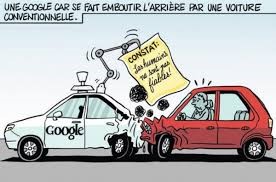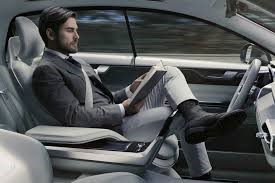On February 14, 2016, Google acknowledged the responsibility of its program in an accident between two vehicles.
During an accident involving Google's Lexus RX450h10 and a bus on May 7, 2016, in Florida, the first death involving an autonomous vehicle occurred. These accidents served as a reminder that autonomous cars were not infallible, and in case of damage, it was necessary to designate a responsible party to compensate the victim. That's why Volvo, followed by Mercedes Benz and Google, announced in 2016 that they would take responsibility for all accidents involving their autonomous vehicles.

Although in France, this statement cannot override legal requirements, these events raise questions about the applicable liability rules for the driver, the evolution of automobile insurance, and the financial impacts on insurers. Indeed, as the driver paradigm evolves, the entity subject to insurance obligations will no longer be the same. With the commercialization of autonomous vehicles expected before 2020, the question of liability attribution becomes an urgent issue to resolve, as it is crucial in adapting insurers' contracts.
In the United States, 23 states have legislated to promote autonomous vehicle development. The NHTSA (U.S. federal agency responsible for road safety) addressed the heterogeneity of regulations by stating that an artificial intelligence-based computer system could have the status of a driver. It established specifications that manufacturers must adhere to for the operation of their autonomous vehicles.
This aligns with consumer expectations, with 78% believing that in autonomous mode, they should not automatically bear responsibility, and it should be shifted to the vehicle creator. In the absence of control over the vehicle, they cannot be deemed at fault.

In France, legislation allows the deployment of embedded systems useful for vehicle autonomy on open roads, limited to testing. However, there are no sanctions for non-compliance with these provisions.
Currently, in France, with a non-autonomous vehicle, the driver is deemed responsible following the involvement of their property in an accident. Their compensation may be reduced or excluded in the event of their fault. This concept of "faultless liability" aims to impose the financial consequences of repairs on the one best able to prevent the damage and/or who had a financial interest in putting the property into circulation. This legal concept encourages the responsible party to maintain their property to limit accident risks.
In the absence of vehicle control, the user can absolve themselves of responsibility and be classified as a passenger. Legislation and jurisprudence suggest that artificial intelligence could be considered the driver, holding its creators responsible. This interpretation is supported by the fact that the autonomous taxi Navya, without a steering wheel or pedals and expected to be commercialized from July 2018, will have its AI's responsibility covered by the company's insurer.
The determination of technical circumstances and responsibilities will be carried out through black boxes (or Event Data Recorders) integrated into automobiles. Similar to airplanes, these devices will establish the final debtors of compensation by tracking the vehicle's activity, recording decisions made by the software, and determining if the error is human or not. This is already happening in the United States following the NHTSA's recommendations, and it is a desire of German authorities.
In France, the insured party owns their personal data. The CNIL (French data protection authority) does not allow insurers, except in case of an offense, to access this data without the insured party's consent, under penalty of criminal sanctions. However, insurers can adjust the user's insurance premium based on their willingness to share their data, even offering prohibitively high rates to those who refuse.
For insurers, this device helps prevent fraud, reduce management costs, and avoid disputes. To grant coverage, insurers may have the right to review the software's programming and impose preventive security obligations on manufacturers. As the risk shifts from the individual to AI, part of automobile insurance must shift from the user to the vehicle's creators.
Nevertheless, the user will retain a level of responsibility through their obligation to maintain the property, especially during manual driving phases. Eventually, manufacturers aim to allow users to regain control of the vehicle for the pleasure of driving. This will require the construction of adapted contracts for users and contracts for companies involved in autonomous vehicle design.
Simultaneously, the vehicle owner, whether an individual or a legal entity, will require damage insurance for both old risks (glass breakage, theft, damage) and new risks (hacking, data theft, cyber risks in general).
To address these new requirements, a pre-financing insurance has been imagined:
For users (modeled on the construction and damage insurance, possibly called "automobile damage insurance"). It would combine the mandatory automobile liability insurance contract, defense and recourse guarantee, and driver guarantee. Its purpose would be the direct compensation of accident victims (both drivers and non-drivers) by the nearest automobile insurer (the insurer of vehicle X covers the damages for individuals present in vehicle X). Consequently, the insurer's management costs would decrease as they only need to determine that their insured did not control the property to take reimbursement action against one of the creators' insurers. The user would, therefore, see a decrease in the amount of their premiums, even if they would have to pay the manufacturer's insurance amount when purchasing or leasing the vehicle.
Autonomous vehicle designers can, to address their product liability, take out additional guarantees to their "post-delivery" insurance. These guarantees will cover mandatory automobile liability in the event of an accident involving an autonomous vehicle without failure, faultless liability resulting from a failure, and criminal fines. These actors will see their premiums increase due to the inclusion of new risks in their activity.
If professionals' insurers do not establish new agreements, they will incur significant management costs. For each accident, they will need to determine the responsibilities of each actor and issue individualized reimbursement actions.
For designers already positioned in the market, coverage of this liability, whether through an insurer or self-insurance, is advantageous as it creates a new barrier to entry. Insurers in this segment will need to leverage their risk management experience to ensure that the reduction in the number of claims does not lead to the disappearance of fleet automobile insurance and a lack of growth in the software designers' insurance market.
The redistribution of responsibilities and the reduction in the number of claims will have a significant impact on insurers' revenue. The automobile market represents 40.9 million insured vehicles in France today, translating to 20.4 billion euros in premiums in 2015, which is 39% of the total property and liability insurance contributions. Mandatory automobile liability coverage, excluding fleets, represents 36% (7.4 billion euros) of these premiums and 51% of the total claim amount (approximately 8.1 billion euros on 7.6 million compensated claims). Although the impact of autonomous vehicles on this non-profitable sector will be limited to 14% of property and liability insurance revenue, it still represents a considerable amount.
Autonomous vehicles, with their first commercialization planned for 2018, will eventually lead to a 90% reduction in accident rates at a constant distance traveled. Although the turnover of the automobile insurance sector is quite long (8.5 years), studies by KMPG and the NHTSA predict an 80% reduction in frequency and a 60% reduction in costs by 2035, when the penetration rate has exceeded 50%, as indicated in the graph below.
An increase of 4.5% (annual) in automobile premiums is expected in the short term following the implementation of the civil liability bill, which will merge civil liability, defense and recourse guarantees, and driver guarantees. In the future, there will be neither a deductible nor a limit, as is already the case with MAIF, MAAF, and Allianz. Ultimately, this new technology will still lead to a redistribution of market shares and a reduction in turnover of approximately 6.7 billion euros if designers decide not to self-insure.
However, this overview needs to be balanced because some issues related to autonomous vehicles have not yet found a solution. These include questions about the qualification of homicides committed by AI, the difficulty of insuring interconnected software, the role of reinsurers in facing this new risk, or the relevance of creating a new guarantee fund. Addressing these points will require a new marketing and financial approach for designers and will impact the pricing of insurance contracts. Insurers must comprehend and adapt their coverage, leveraging their risk management expertise.
This new situation could provide insurers covering businesses with a significant competitive advantage over insurers of individuals if they take advantage of the market's re-segmentation. Indeed, the premiums of the former will increase, while those of the latter will decrease, assuming the players in this new market do not self-insure. In any case, the significant decrease in turnover in the automotive sector will push them to find new growth potentials and insure new risks.
From this perspective, insurers of individuals can capitalize on the development of new assets whose insurance obligation is expected to grow, such as gyropods, monowheels, flying cars and motorcycles, fez, as well as robots and drones. This will result in an increase in insurable mass and, consequently, a growth in collected premiums, whether for insurers of individuals or businesses.




